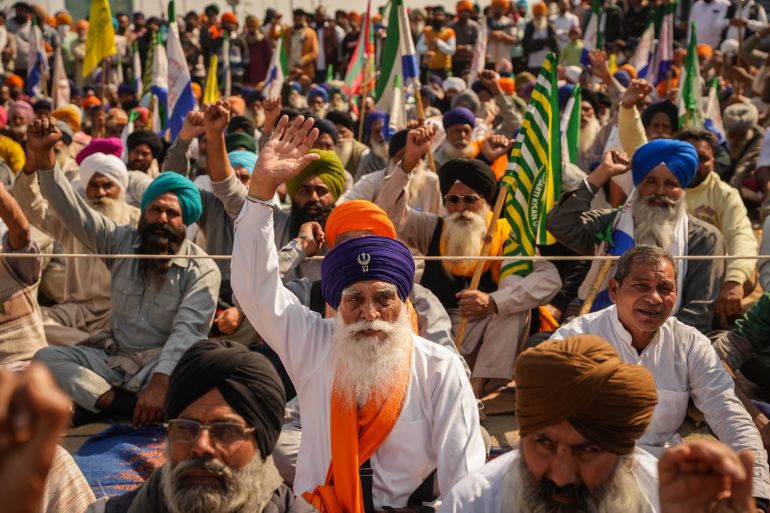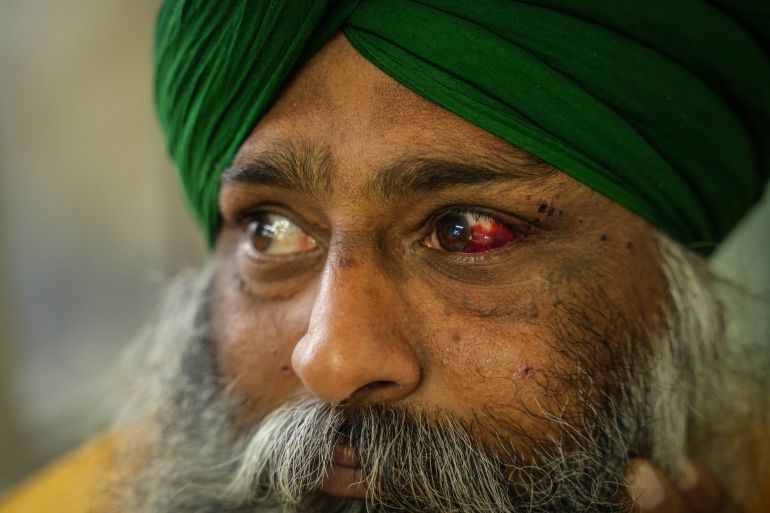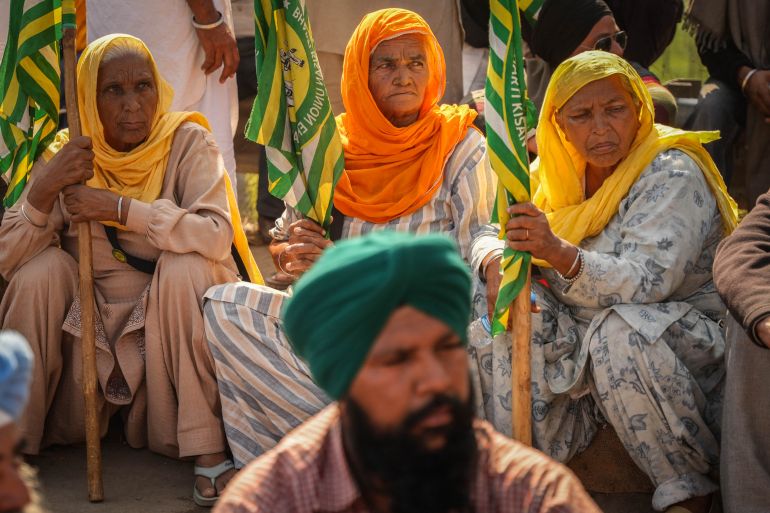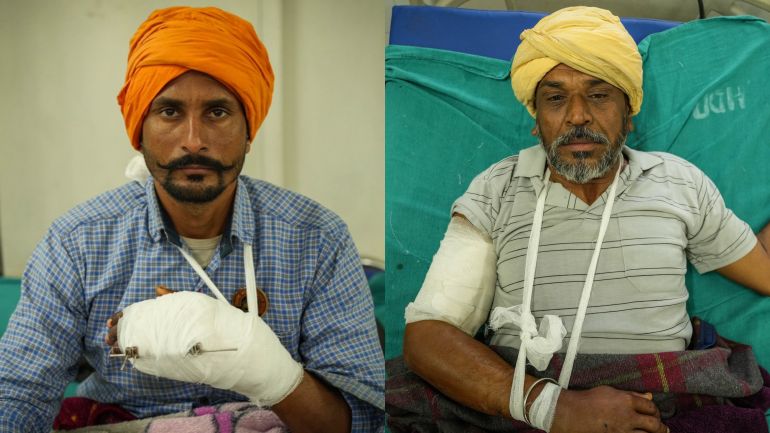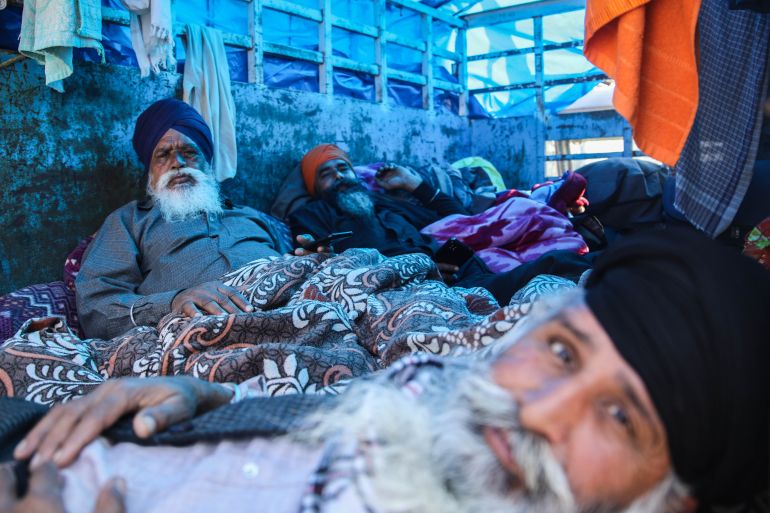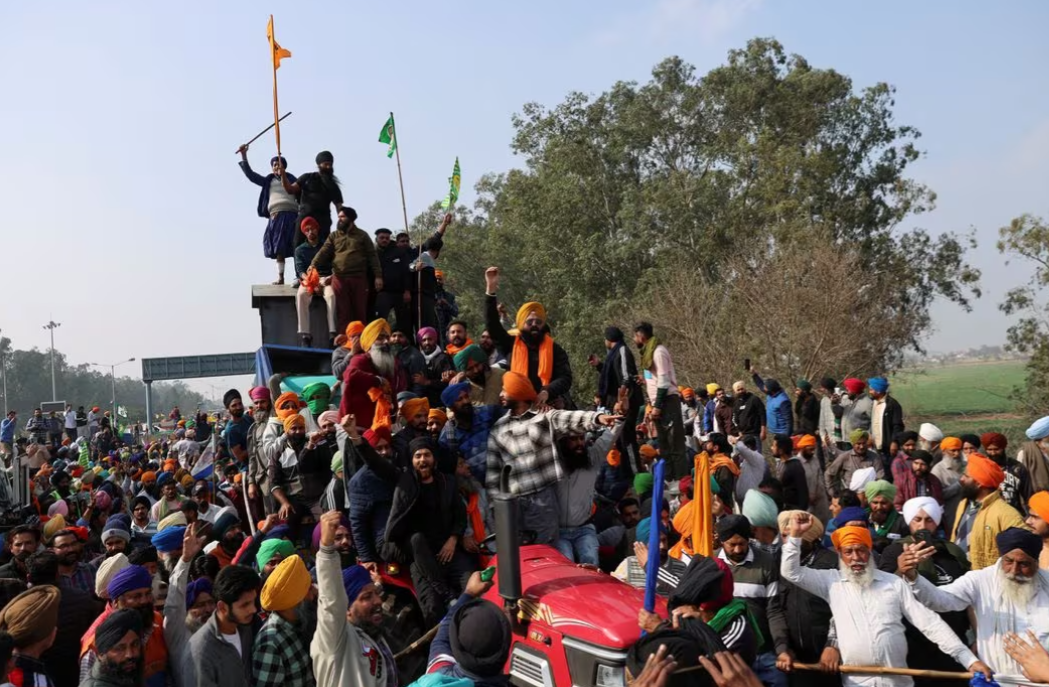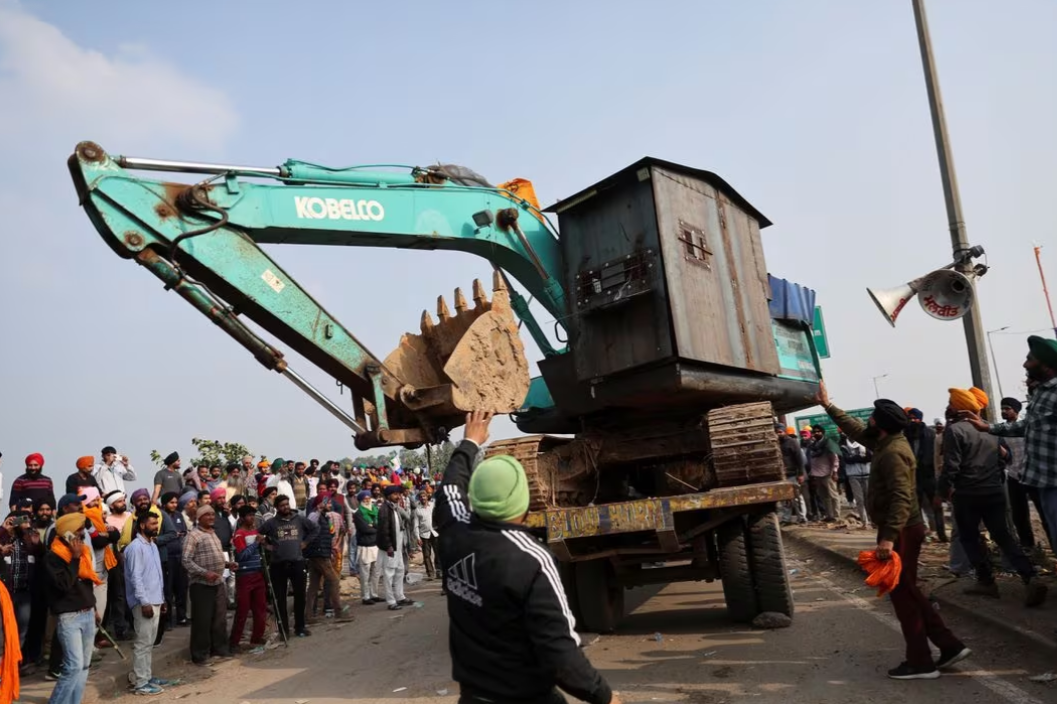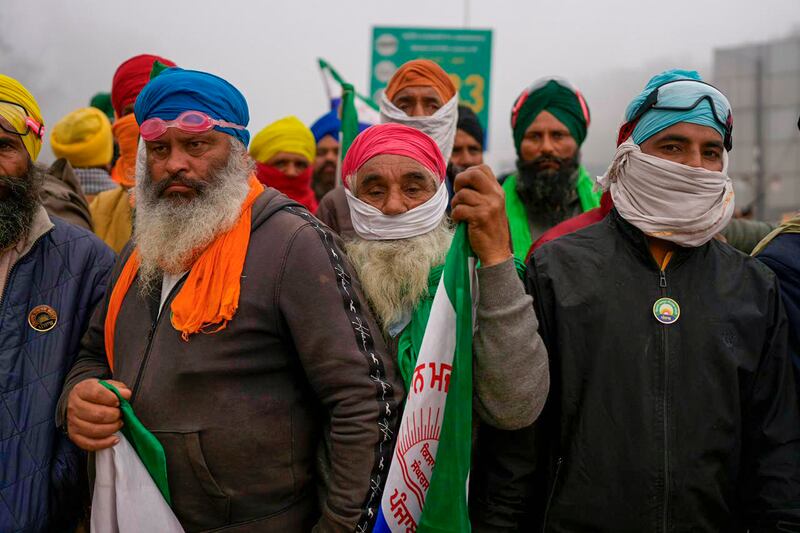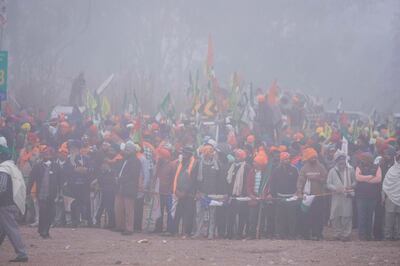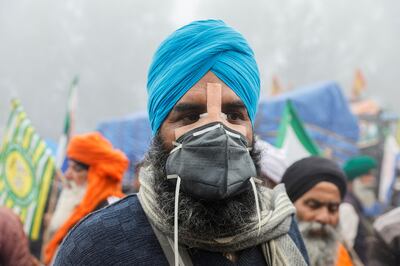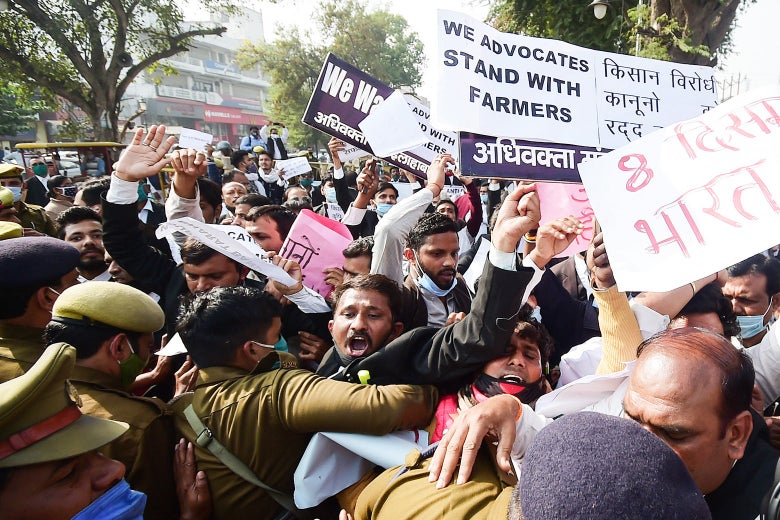Sheikh Saaliq
The Associated PressStaff
Tuesday, January 26, 2021
Thousands of farmers protest in India

NOW PLAYING
Thousands of farmers stormed the Red Fort in New Delhi to demand the withdrawal of new laws which they say will impact their earnings.
NEW DELHI -- Tens of thousands of farmers marched, rode horses and drove tractors into India's capital on Tuesday, breaking through police barricades to storm the historic Red Fort -- a deeply symbolic act that revealed the scale of their challenge to Prime Minister Narendra Modi's government.
As the country celebrated Republic Day, the long-running protest turned violent, with farmers waving farm union and religious flags from the ramparts of the fort, where prime ministers annually hoist the national flag on the country's August independence holiday. Riot police fired tear gas and water cannons and set up barricades in an attempt to prevent the protesters from reaching the centre of New Delhi, but the demonstrators broke through in many places.
People watched in shock as the takeover of the fort, which was built in the 17th century and served as the palace of Mughal emperors, was shown live on hundreds of news channels. Protesters, some carrying ceremonial swords, ropes and sticks, overwhelmed police.
Related Stories
India's top court suspends implementation of new farm laws
The farmers have been staging largely peaceful protests for nearly two months, demanding the withdrawal of new laws that they say will favour large corporate farms and devastate the earnings of smaller scale farmers.
The contentious legislation has exacerbated existing resentment among farmers, who have long been seen as the heart and soul of India but often complain of being ignored by the government. As their protest has gathered strength, it has rattled the government like never before since they form the most influential voting bloc in India and are also crucial to its economy.
"We want to show Modi our strength," said Satpal Singh, a farmer who drove into the capital on a tractor along with his family of five. "We will not surrender."
Leaders of the farmers said more than 10,000 tractors joined the protest, and thousands more people marched on foot or rode on horseback while shouting slogans against Modi. At some places, they were showered with flower petals by residents who recorded the unprecedented protest on their phones.
Authorities used tear gas, water cannons and placed large trucks and buses in roads to try to hold back crowd, including rows upon rows of tractors, which shoved aside concrete and steel barricades. Police said one protester died after his tractor overturned, but farmers said he was shot. Several bloodied protesters could be seen in television footage.
Farmers -- many of them Sikhs from Punjab and Haryana states -- tried to march into New Delhi in November but were stopped by police. Since then, unfazed by the winter cold and frequent rains, they have hunkered down at the edge of the city and threatened to besiege it if the farm laws are not repealed.
"We will do as we want to. You cannot force your laws on the poor," said Manjeet Singh, a protesting farmer.
The government insists that the agriculture reform laws passed by Parliament in September will benefit farmers and boost production through private investment. But the farmers fear it will leave those who hold small plots behind as big corporations win out.
The government has offered to amend the laws and suspend their implementation for 18 months. But farmers insist they will settle for nothing less than a complete repeal and plan to march on foot to Parliament on Feb. 1.
Farmers are the latest group to upset Modi's image of imperturbable dominance in Indian politics.
Since returning to power for a second term, Modi's government has been rocked by several convulsions. The economy has tanked, social strife has widened, protests have erupted against laws some deem discriminatory and his government has been questioned over its response to the coronavirus pandemic.
In 2019, the year that witnessed the first major protests against his administration, a diverse coalition of groups rallied against a contentious new citizenship law that they said discriminated against Muslims.
But the latest protests -- which began in northern states that are major agricultural producers -- have triggered a growing farmer rebellion that is fast spreading to other parts of the country, presenting a serious challenge to Modi's government.
Agriculture supports more than half of the country's 1.4 billion people. But the economic clout of farmers has diminished over the last three decades. Once producing a third of India's gross domestic product, farmers now account for only 15% of the country's $2.9 trillion economy.
More than half of farmers are in debt, with 20,638 killing themselves in 2018 and 2019, according to official records.
Devinder Sharma, an agriculture expert who has spent the last two decades campaigning for income equality for Indian farmers, said they are not only protesting the reforms but also "challenging the entire economic design of the country."
"The anger that you see is compounded anger," Sharma said. "Inequality is growing in India and farmers are becoming poorer. Policy planners have failed to realize this and have sucked the income from the bottom to the top. The farmers are only demanding what is their right."
Modi has tried to dismiss the farmers' fears as unfounded and has repeatedly accused opposition parties of agitating them by spreading rumours.
The protests overshadowed Republic Day celebrations, in which Modi oversaw a traditional lavish parade along ceremonial Rajpath boulevard displaying the country's military power and cultural diversity. Authorities shut some metro train stations, and mobile internet service was suspended in some parts of the capital, a frequent tactic of the government to thwart protests.
The parade was scaled back because of the pandemic. People wore masks and adhered to social distancing as police and military battalions marched along the route displaying their latest equipment.
Republic Day marks the anniversary of the adoption of the country's constitution on Jan. 26, 1950.
Police said the protesting farmers broke away from the approved protest routes and resorted to "violence and vandalism."
The group that organized the protest, Samyukt Kisan Morcha, or United Farmers' Front, blamed the violence on "anti-social elements" who "infiltrated an otherwise peaceful movement."
------
AP video journalist Rishabh R. Jain contributed to this report
RELATED IMAGES

Indian Railway Protection Force (RPF) personnel march during Republic Day celebrations in Hyderabad, India, Tuesday, Jan. 26, 2021. (AP Photo/Mahesh Kumar A.)

Sikhs wave the Nishan Sahib, a Sikh religious flag, as they arrive at the historic Red Fort monument in New Delhi, India, on Jan. 26, 2021. (Dinesh Joshi / AP
Indian farmers storm historic Red Fort in Republic Day protests
Growers have camped outside New Delhi for almost 2 months
Thomson Reuters · Posted: Jan 26, 2021

Thousands of Indian farmers protesting against agricultural reforms overwhelmed police on Tuesday and stormed into the historic Red Fort complex in New Delhi after tearing down barricades and driving tractors through roadblocks.
Police fired tear gas in an unsuccessful bid to force the protesters back. One protester was killed, a witness said, and Delhi police said 86 officers had been injured across the city.
Some of those who scaled the walls of Red Fort carried ceremonial swords, scattering police who tried to prevent them from entering. Footage from Reuters partner ANI showed police jumping from the ramparts to escape. Once inside, the protesters hoisted flags.
Angered by laws they say help large, private buyers at the expense of producers, farmers have camped outside the capital for almost two months, posing one of the biggest challenges to Prime Minister Narendra Modi since he came to power in 2014.
CBC EXPLAINSWhat's behind the farmers' protests that are blocking highways in India
Indian farmers escalate protest against new laws with countrywide strike
"Modi will hear us now, he will have to hear us now," said Sukhdev Singh, 55, a farmer from the northern state of Punjab.
The body of one protester draped in an Indian tricolour lay in the street after the tractor he rode overturned in one clash, said a witness, Vishu Arora.
"He died right there," Arora said.
.jpg)
Indian farmers descend on capital to protest reforms
A Reuters witness saw several police and protesters with head injuries following clashes at the Red Fort, from whose ramparts Modi delivers an annual speech.
The government ordered internet services in some parts of the capital to be blocked, according to mobile carrier Vodafone Idea, in an attempt to prevent further unrest.
Breakaway protests condemned
Tens of thousands of farmers began the day in a convoy of tractors festooned with flags along the city's fringes.
But hundreds of protesters — some on horseback — broke away from approved routes, heading for government buildings in the city centre where the annual Republic Day parade of troops and military hardware was taking place.
OPINION Farmers' protests in India are not just about land rights. They're about our very identity
Indian farmers reject talks with government amid blockades, furor over agriculture legislation
They commandeered cranes and used ropes to tear down roadblocks, forcing constables in riot gear to give way, Reuters witnesses said. A second group rode tractors to a traffic junction, also breaching barricades after clashes with police.
Police accused those who diverged from the agreed routes of "violence and destruction."
"They have caused great damage to public property and many police personnel have also been injured," a police statement said.

Farmers in New Delhi take part in a tractor rally on Tuesday as they demonstrate against the Indian government's recent agricultural reforms. (Money Sharma/AFP/Getty Images)
Protest organizer Samyukt Kisan Morcha said the groups deviating from set routes did not represent the majority of farmers.
"We also condemn and regret the undesirable and unacceptable events that have taken place today and dissociate ourselves from those indulging in such acts," the group of farm unions said in a statement.
Amarinder Singh, chief minister of Punjab state where many of the protesters came from, called the clashes "shocking."
"The violence by some elements is unacceptable," he said in a tweet. "It'll negate goodwill generated by peacefully protesting farmers."
Farmers' unrest concerns government
Agriculture employs about half of India's population of 1.3 billion, and unrest among an estimated 150 million landowning farmers worries the government.
Nine rounds of talks with farmers' unions have failed to end the protests, as farm leaders rejected the government's offer to delay the laws for 18 months, making a push for repeal instead.
"The farm organizations have a very strong hold," said Ambar Kumar Ghosh, an analyst at New Delhi think-tank the Observer Research Foundation.
"They have the resources to mobilize support, and to continue the protest for a long time. They have also been very successful in keeping the protest really focused."
India showcases its military hardware with a parade every year on Republic Day, which marks the adoption of its constitution in 1950.

